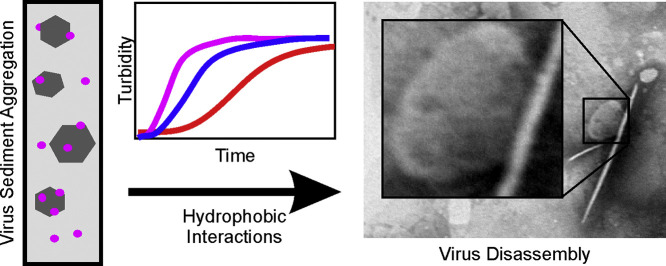- Record: found
- Abstract: found
- Article: not found
Heteroaggregation of an enveloped bacteriophage with colloidal sediments and effect on virus viability

Abstract
Four sediments in the colloidal size range: goethite, montmorillonite, illite, and kaolinite, were suspended with the bacteriophage φ6, a model enveloped virus, to determine relative rates of heteroaggregation and the effect of aggregation on virus viability. Turbidity was measured on combinations of virus and each sediment type at low concentration to determine aggregation rates. Aggregation of sediment with virus occurred regardless of mineral type, and larger fraction of virus is expected to aggregate with increasing sediment concentration leading to higher deposition rates. The negatively charged sediments, aggregated with φ6 (also negatively charged at neutral pH) at a faster rate than the positively charged sediments, yielding turbidity slopes of 4.94 × 10 −3 s −1 and 7.50 × 10 −4 s −1 for φ6-montmorillonite and φ6-illite aggregates, respectively, and 2.98 × 10 −5 s −1 and 2.84 × 10 −5 s −1, for φ6-goethite and φ6-kaolinite, respectively. This indicates that the interaction between sediments and virus is hydrophobic, rather than electrostatic. Large numbers of virions remained viable post-aggregation, despite the fragility of the viral envelope, indicating that small-sized aggregates, which may travel more readily through porous media, may pose an infection risk. The fraction of φ6 that remained viable varied with sediment type, with montmorillonite-φ6 aggregates experiencing the greatest reduction in infectivity at 35%. TEM analyses reveal that in all sediment-φ6 combinations, infectivity loss was likely due to disassembly of the viral envelope as a result of aggregation.
Graphical abstract
Highlights
-
•
Sediments interact with enveloped viruses but effects on viability are unknown.
-
•
Light scattering measured aggregation rates of virus with four mineral types.
-
•
Heteroaggregation was hydrophobic and faster with negatively-charged sediments.
-
•
The greatest reduction in infectivity occurred in virus-montmorillonite aggregates.
-
•
Aggregation with sediment caused virus disassembly and infectivity loss.
Related collections
Most cited references45
- Record: found
- Abstract: not found
- Article: not found
Acid—base interfacial interactions in aqueous media
- Record: found
- Abstract: not found
- Article: not found
Analysis of bacteriophage T7 early RNAs and proteins on slab gels.
- Record: found
- Abstract: found
- Article: not found

